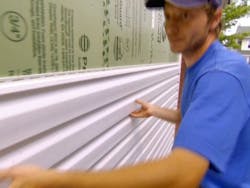Conceal Seams to Make the Siding Job Shine
Ed Ladeuceur, owner of StormTite Home Improvement, in Warwick, R.I., is adamant about seams. “I don’t want any seam showing from the front of the house if I can avoid it,” he says. A job where it appears that there are no seams “makes my job shine,” he says, and is a saleable point with many homeowners.
The original point of vinyl siding, notes Jason Kersch, sales manager at Major Homes, in Flushing, N.Y., was to replicate the look of wood lapped siding, which can be crafted to appear seamless. It’s not just that seams in vinyl siding distract from that appearance, it’s that they can open up and create a shadowing effect and pull the siding off the house, he says.
Tips & Tricks
With a little forethought, siding seams can be minimized. One reason is that, in addition to standard 12-foot lengths, vinyl siding manufacturers began making longer panels years ago in an effort to give siding contractors more leverage in the installation. Here are some tips on how to minimize visible seams:
• Go to great lengths. When it comes to keeping seams out of sight, 16-foot panels “will reduce the amount of overlap seams,” says Dave Hurst, owner of Hurst Exteriors, in Denver, Pa. Most vinyl siding installers use 12-foot panels, says Dave Verbofsky, manager of installation and training for Ply Gem Siding Group and a trainer in the Vinyl Siding Institute’s certified installer program. Going to a 16-foot or longer panel will eliminate 50 percent of the seams, Verbofsky says. Kersch notes that about one out of five Major Homes vinyl siding jobs uses 25-foot panels. “It doesn’t work on every house,” he adds, but where it does, that often sells the job.
That’s especially true for the type of customer who, Kersch says, is someone who is doing this siding work because he wants to, not because he has to.
• Consider sightlines. Think about where traffic is expected, Hurst says. Visualize sightlines from auto or on foot. For a clean, crisp effect that maximizes the look of new siding, the front of the house should be as seamless as possible. Ditto areas visible from a deck, Ladeuceur says.
• Don’t wing it. Plan your layout to take advantage of windows, doors, shutters, and other wall interruptions to conceal seams. Downspouts are also useful in this regard, so is shrubbery: “Hide the seams behind bushes,” Ladeuceur says. “There are many ways.”
Major Homes tries to locate seams where people won’t see them, which is typically the side of the house, where installers arrange the overlap so that the shadow line can’t be seen from the front of the house.
• Design for it. On a two-story house that’s 30 feet wide or wider in front, design a decorative break in the center or between first- and second-floor windows using vertical rather than horizontal panels. This shortens the horizontal runs so that they can be covered without creating a seam.
• Avoid patterns. “We try to avoid having laps too close together or in a step pattern on the wall,” Hurst says. “Patterns tend to draw the eye to laps rather than the overall wall of siding.” He adds that “a better-quality panel will help to eliminate cupping or oil canning on walls that have imperfections in the framing of the structure.”
Combination Tactics
If you really plan it, Verbofsky says, you can cut the seams down to zero on the front of a small house by going to longer panels or combining 12- and 16-foot lengths.
He also suggests installing foam-backed siding, which will drastically reduce the number of noticeable seams, or polypropylene shakes and shingles, which are designed to eliminate laps. PR
